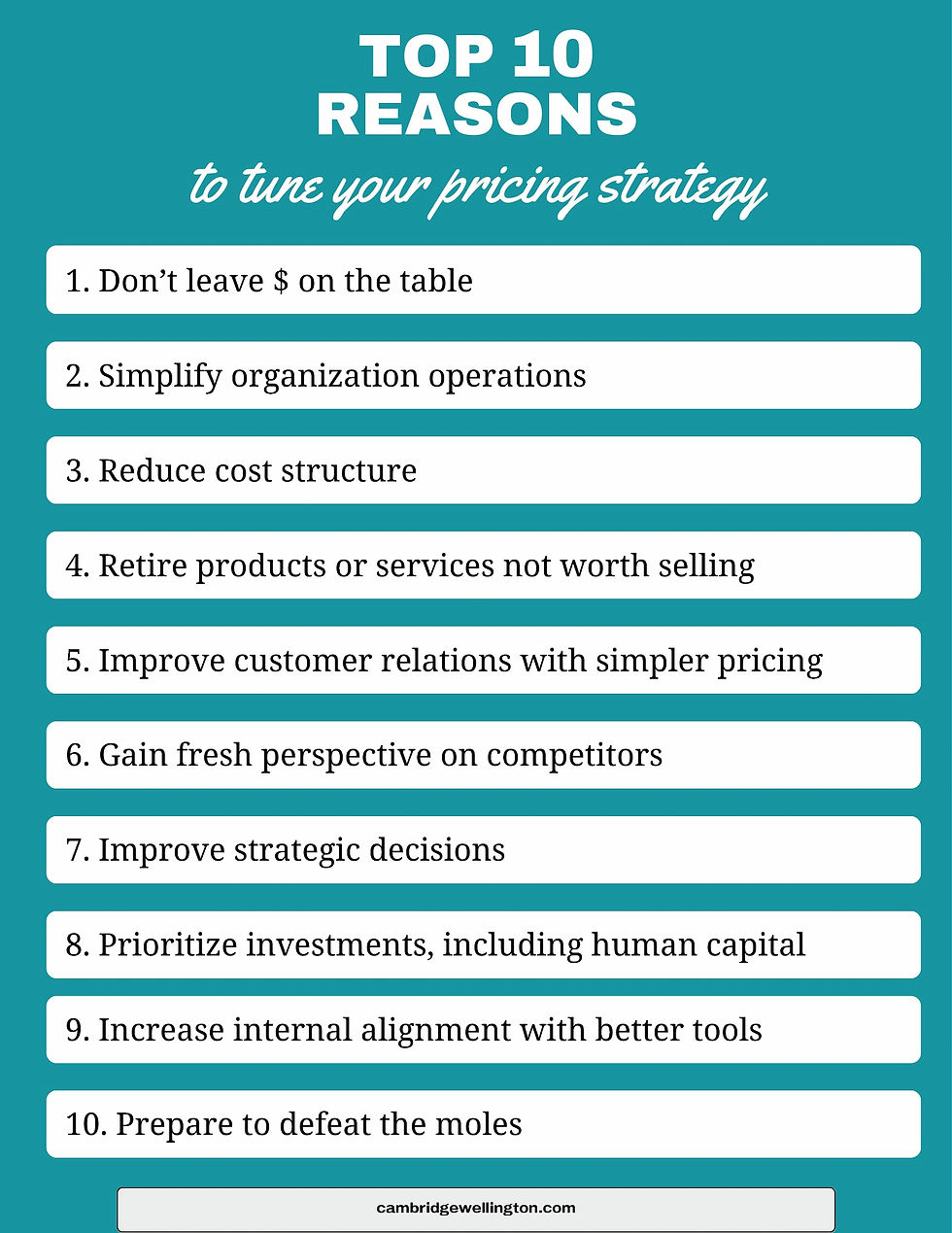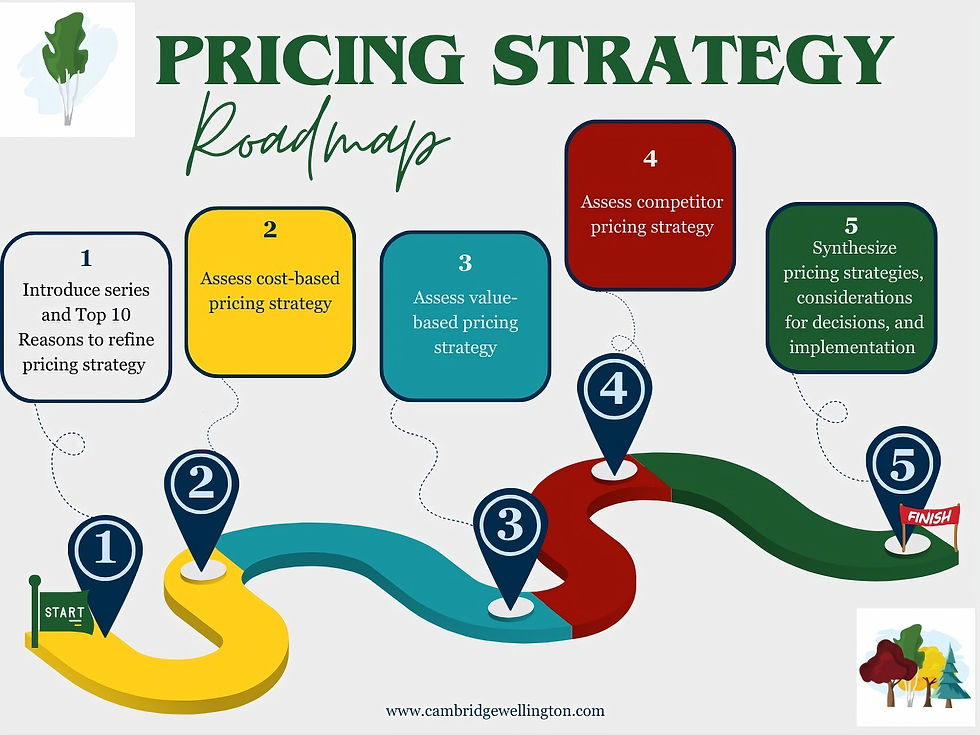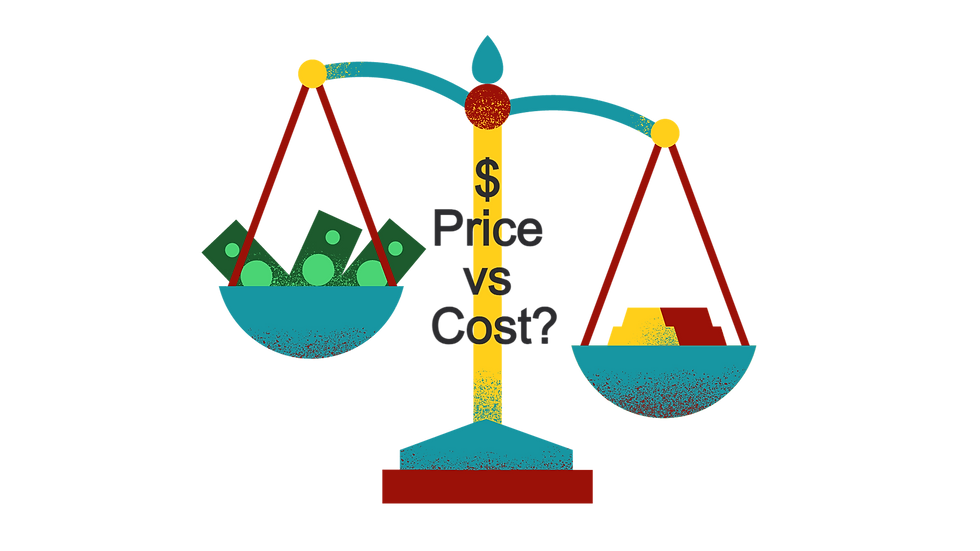How To Transform Your Pricing Strategy: A 5-Part Roadmap
- Katherine Hatter
- Oct 5, 2023
- 4 min read
Updated: Jan 10, 2024
The Challenges of Pricing Products & Services
Pricing products and services is a complex undertaking. It feels like playing a game of Whac-A-Mole, where the player must hit as many moles as possible within a certain time limit to earn points and advance to the next level. Here are some specific parallels between Whac-A-Mole and pricing strategy:

Just like Whac-A-Mole requires fast reflexes, with pricing strategy, you need to be quick on your feet. You can't wait for a problem to become too big or you'll be overwhelmed. (In addition to being a pastime, whac-a-mole has been used in studies on human behavior and reaction time.)
In Whac-A-Mole and pricing strategy, you have to prioritize. Your organization may face sharply increasing costs, new competitors, and recession risk at the same time.
Whac-A-Mole and pricing involves unpredictability - you never know what will pop up where. Conditions can change rapidly, and you need to be ready to adjust your game strategy accordingly.
Finally, with Whac-A-mole and pricing, you have limited time and resources and need to act strategically. If you offer too many discounts, you may hurt your bottom line, but if you fail to adjust your price at all, you may risk losing customers to competitors.
Here are the top 10 reasons to consider refining your pricing strategy:

If any of the above potential benefits resonate with you, then you’ll want to follow this pricing strategy series...
Solving the Pricing Strategy Puzzle: An Easy-to-Follow Roadmap
Navigating the pricing strategy puzzle can be daunting, particularly for small and medium-sized enterprises, which are often bogged down by the daily demands of running a business and wearing multiple hats with limited resources. Organizations may feel stuck and uncertain about where to even start.
Our 5-part series is here to help. We will explore the key pricing strategies that every organization should assess (cost-based, value-based, competitive, dynamic) and include pricing strategy examples to help identify the right fit for your organization. With our easy-to-follow roadmap (see image below) and step-by-step approach with helpful visuals, you'll feel empowered to tune your pricing strategy.

Let Me Introduce Myself & My Passion for Pricing Strategy Pricing strategy is currently my absolute favorite topic - I enjoy thinking about all the factors that need to be considered, and I love that pricing is an ever-evolving subject. I've worked on numerous pricing strategy projects in a variety of industries, with a primary focus on entrepreneurial organizations. With concentrations in Entrepreneurship, Finance and Strategy from Chicago Booth, I even returned as an alum to take a course dedicated to pricing strategy. Many examples and tips in this series will be through the lens of small and medium sized organizations. I'm excited to share some of my knowledge with you, and I hope to learn from your experience as well.
Pricing, Pricing Strategy, & Pricing Models
Let’s start with basic terms and concepts that are foundational to this series. "Pricing" refers to the amount you charge for products or services. When it comes to setting prices for your products or services, it's helpful to understand the difference between a pricing strategy and a pricing model. “Pricing strategy" is a plan or approach to determining those costs. A "pricing model" is a system used to determine the specific prices to charge for your products or services. Although "pricing strategy" and "pricing model" are often used interchangeably, here are key differences:

Based on my experiences with small and mid-sized organizations, it is often possible to simultaneously develop both pricing strategy and pricing model(s). Ultimately, the right pricing strategy and model for your organization will depend on a variety of factors, including your industry, target market, and competitive landscape.
Understanding Dynamic Pricing What is “dynamic pricing” and how does that fit into this? Dynamic pricing is the practice of changing the price based on market conditions. For example, charging more for pet sitting over holidays due to higher customer demand and fewer people wanting to work on holidays. (We will incorporate dynamic pricing throughout this series.)
Summary of Key Terms To summarize, a "pricing strategy" outlines the overall approach an organization takes to price its products or services while a "pricing model" determines the price of a product or service. Incorporating "dynamic pricing" can help optimize performance by adjusting prices based on market demands and other changing factors. By adopting the most appropriate pricing model and strategy, organizations can charge a fair price for their products or services while staying competitive in the market.
Determining the Necessary Pricing Models: An Example
Next, let’s discuss figuring out which pricing models to build, since most organizations require more than one and this is a foundational first step in tuning pricing strategy.

When leading a pricing project for a recreational center, it became clear from my initial discussions with the executive team that two different pricing models needed to be built for food and accommodations/lodging. Here's why:
Customers have the option to purchase food, lodging or both separately
Food and lodging had different cost drivers, customer value concepts, and levels of competition
This decision was vital to moving forward with improving the center's pricing strategy and tools, and ultimately their performance.
What’s Next
Homework:
Figure out pricing models your organization needs to build, leveraging the aforementioned example.
To avoid overthinking and getting stuck, find someone in your organization or network to talk things through as you follow this series.
Stay tuned for our next article in the series, which will explore assessing cost based pricing to determine prices.

Don't miss out on the next articles in the series - subscribe below!
If you're looking for additional assistance with your organization's pricing strategy, feel free to reach out to us.
-----------



Comments